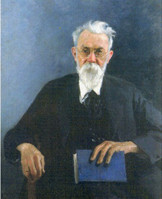
Birthday anniversary of Vladimir I. Vernadsky, naturalist, thinker and public figure
I am fully aware that I can get excited about something false, misleading, to go down a path that will lead me into the jungle; but I cannot refuse to follow it, I hate all kinds of fetters to my thought, I cannot and do not want to force it to go on the track, which is practically important, but one that would not allow me to understand, even a little more, the issues that plagued me. This hunting, this desire - is the basis of any scientific activity.
V. I. Vernadsky
February 28 (March 12), 1863 in St. Petersburg, in the family of a professor and economist Ivan Vernadsky was born an outstanding thinker and public figure of the 20th century, founder of the complex of modern sciences on Earth, such as geochemistry, biogeochemistry, radio geology, hydrogeology, etc., academician of the Petersburg Academy of Sciences (from 1912) and the Academy of Sciences of the USSR, the first president of the Academy of Sciences of Ukraine (1919), and Vladimir I. Vernadsky.
In 1881, having graduated from the First St. Petersburg High School, Vladimir enrolled in the University of St. Petersburg, Natural Sciences Department of the Physics and Mathematics Faculty. In the university, he attended the lectures of eminent scientists: D. I. Mendeleyev, N. A. Menshutkin, I. M. Sechenov, P. A. Kostychev, A. A. Inostrantsev and others. Soil scientist V. V. Dokuchaev had a great impact on the future development of scientific activity of Vernadsky as a mineralogist, geochemist and biogeochemist.
After graduation, in the period from 1886 to 1888, Vladimir was the curator of the Mineralogy Museum of St. Petersburg University.
In 1888, Vernadsky was sent abroad; he worked in Italy, Germany and France. After returning to Russia in 1890, he was appointed lecturer at Moscow University. In 1891, in the University of St. Petersburg, Vladimir Ivanovich defended his thesis for a Master of mineralogy and geognosy titled, "The group of sillimanite and the role of alumina in silicates," and in 1897 received his doctor’s degree for his work "On phenomena of slip of crystalline substance."
In 1898, Vernadsky was appointed Professor of the University of Moscow. In 1906 he was elected an associate of the Academy of Sciences, in 1908 - an extraordinary academician, and in 1912 - an ordinary academician.
In 1904 Vernadsky was a delegate to the Provincial Congress that demanded the introduction of the constitution, civil liberties and elections to the State Duma. In 1905, he contributed to the creation of the Constitutional Democratic Party, and until 1918 had been a member of its Central Committee.
In 1911, Vladimir Ivanovich with a group of scientists and professors making a protest against the reactionary policies regarding higher education, left the University of Moscow and moved to St. Petersburg.
Constant subject of study of the academician Vernadsky was the history of minerals and chemical elements of the Earth. Before Vladimir Ivanovich, minerals had mainly been studied in terms of their external properties - shape, color, hardness, size, etc. Very little attention was paid to determine the causes and conditions of formation of minerals, patterns of their relationships with one another, their intrinsic properties and structure. Vernadsky developed genetic mineralogy, stressed the need to study not only minerals, but mineral-advanced processes; he also indicated mineral paragenesis as an important criterion in the perception of their origin.
On the basis of works in the field of study of the structure of the most important group of minerals - aluminum silicates that began back in 1890-1891, the scientists developed the theory of the structure of aluminum silicates – the theory of kaolin or mica nucleus, which later a celebrated French chemist Le Chatelier called a genius one.
The scientist insisted on the study of the productive forces of Russia, stating that in the depths of the country there were all kinds of minerals. Saying this, he proceeded from the fact that in the territory of Russia there were the remains of almost all geological formations, and in its depths ran geological, including ore-forming, processes common to all the rest of the terrestrial globe. In 1915, Vernadsky established the Commission for the study of natural productive forces of Russia (KEPS). Subsequently the Commission gave birth to: the Institute of Geography, Institute of Mineralogy and Geochemistry, Radium Institute, Ceramic Institute, Optical Institute, Commission for the Study of the permafrost, Commission on Mineral Waters, Meteorite Committee, Commission on Isotopes and others.
From 1922 to 1939, Vladimir Ivanovich was the director of the State Radium Institute established by him. In 1927, at the USSR Academy of Sciences he founded the Department of living matter, converted in 1929 into Biogeochemical Laboratory, which later became the Institute of Geochemistry and Analytical Chemistry n. a. Vernadsky.
Vernadsky carried out a major research to highlight the role and importance of M. V. Lomonosov in Russian and world science, collected manuscripts of the first Russian naturalist.
Vladimir Vernadsky died January 6, 1945 and was buried in Moscow's Novodevichy Cemetery.
Lit.: Баландин Р. К. Вернадский: жизнь, мысль, бессмертие. М., 1979; Вернадский В. И. Биосфера и ноосфера. М., 2007; Вернадский В. И. Пережитое и передуманное. М., 2007; Вестник Академии наук СССР. 1945. № 3; Мочалов И. И. Владимир Иванович Вернадский (1863-1945). М., 1982; Электронный Архив В. И. Вернадского: сайт. 1999-2007. URL: http://vernadsky.lib.ru/.
Based on the Presidential Library’s materials:
Пророк: эпизоды жизни академика В. И. Вернадского. М., 2008. Фильм 1;
Пророк: эпизоды жизни академика В. И. Вернадского. М, 2008. Фильм 2.

